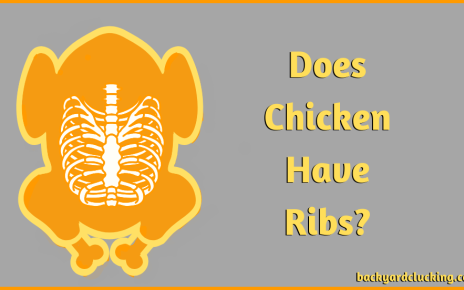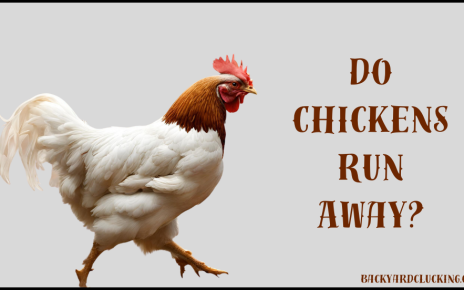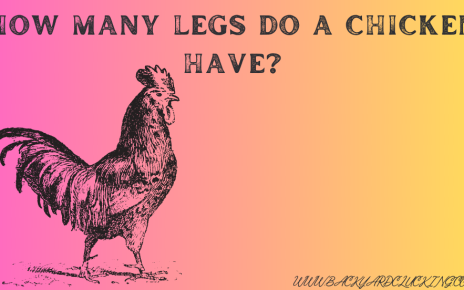Like other birds, chickens possess wings as part of their biological makeup. Despite the modern inability to fly in most domesticated chickens, their wings still serve various purposes you might need to be aware of. In this article, we’ll dive into some lesser-known reasons chickens have wings and how they use them.
Why do chickens have wings if they can’t fly?
Chickens, the domesticated birds that have been a mainstay of our diets for centuries, are known for many things, such as providing us with delicious eggs and meat. However, one of the most striking things about these birds is their wings. It’s a curious thing to note that chickens have wings but can’t fly.
So why do they have wings at all? It turns out that wings play a crucial role in chickens’ survival. They use their wings for the following purpose:
Protection and Warmth
Chickens use their wings to shield their bodies from the cold, especially during winter or cold nights. They can fluff up their feathers and tuck in their heads into their wings to keep warm, creating a natural insulation that traps their body heat to regulate their temperature.
Social Interaction
Wings play an essential role in the social interactions and behaviors of chickens. These birds establish a “pecking order” hierarchy within their flock. When trying to assert dominance, they may use their wings to intimidate other chickens by extending and fluffing them, making them appear larger and more threatening.
Balance and Stability
While chickens might not soar up in the air like some other birds, their wings have evolved to provide balance and stability while walking, running, or perching. They extend their wings out to distribute their weight evenly while steadying themselves, which can be particularly helpful in navigating uneven surfaces or while climbing.
Communication
Chickens communicate using a variety of vocalizations and body language, with wings being an essential part of this system. From warning fellow chickens of danger to expressing their mood, chickens use their wings to convey various messages. For example, a hen might gently spread her wings for her chicks to come near, signaling a moment of rest and warmth.
Defensive Mechanisms
Even though their flying abilities are limited, chickens can use their wings to escape danger. They will flap their wings vigorously to gain enough lift to fly for short distances, just enough to escape from predators. In addition, their wings can be used as a form of self-defense against attackers. Chickens might spread their wings and flap them to scare away a threat or to protect their young ones.
Mating Rituals
Roosters use their wings as part of their courtship rituals to impress hens. This behavior, known as tidbitting, involves a rooster picking up small bits of food, making a particular sound, and then dropping the food while bobbing his head. Simultaneously, the rooster will also extend and flap his wings to grab the hen’s attention and to present himself as a potential mate.
Chickens: The Limited Flyers Overview
Chickens (Gallus gallus domesticus), often associated with their inability to fly, can indeed fly, albeit for limited distances and durations. In this article, we will delve into the scientific reasons behind their flight abilities, factors that affect their flying capabilities, and the extent of their flight.
Scientific Reason Behind Chickens’ Ability to Fly:
Contrary to popular belief, chickens are capable of flying. However, their flight is quite different from that of other birds. This is mainly due to their body structure and muscle mass distribution. Chickens have a large breast muscle, which is helpful for short bursts of vertical takeoff; however, their wing muscles are comparatively small, which restricts their ability to sustain long-duration flights.
Distance and Duration of Flight:
Chickens have the ability to fly, but not in the traditional sense that other birds do. Their heavier build and muscular structure limit them to short bursts of flight for only a few seconds at a time. Factors such as location, breed, and nutrition may also interfere with their flying abilities.In general, they typically achieve speeds of approximately 10 mph, maintaining this pace for durations of 10 to 15 seconds.
The distance they can travel is determined by the height from which they take off. If there are no obstacles in their way, a chicken flying from 10 feet high could journey approximately 30 – 40 feet away. The world record for the longest flight distance of 301.5 feet was set in 2014 by one brave chicken! Flying may seem like an improbable feat for chickens, but as this record shows, it is not impossible.
External Support for Flight
Although chickens are not heavily reliant on external factors such as wind or slopes to achieve flight, these elements can sometimes assist in extending the duration and distance of their flights. For example, a strong wind might help them take off with greater ease, whereas a slope might offer an incline to aid in the flight path.
Factors Affecting a Chicken’s Flying Capabilities:
Several factors contribute to varying flight capabilities among chickens, including:
- Physical Build: The physical build of a chicken, especially its wing-to-body weight ratio, affects its flying abilities. Heavier chickens with larger bodies may struggle to achieve lift-off or maintain flight, while lighter individuals may fare better.
- Age: As chickens age, their flying capabilities often decline due to factors such as weight gain and muscle deterioration.
- Breed: The breed of a chicken plays an integral role in determining flight abilities. Some breeds, such as Bantam chickens, are more likely to fly than larger breeds.
- Nutrition: A balanced diet with a sufficient amount of protein helps support the development of strong muscles and feathers essential for flying.
Can Chickens Leap Over Fences?
This is a difficult question to answer – it all depends on the height of your fence. Some breeds are more agile than others, such as the California White, known for its escape artist tendencies. Nonetheless, chickens can be quite crafty and use objects to give themselves a boost over a fence.
In general, a six-foot tall fence should be enough to keep them within the boundaries of your backyard. That said, some chickens are very motivated to explore and may surprise you with their ability to get out! On the other hand, many chicken owners have small picket fences and never experience any trouble with their poultry going over.
Provide your chickens with enough space and plenty of the things they need, and there’s a good chance they won’t feel the need to escape. This is especially true if they’re content within their environment!
Of course, this does not mean you should ignore the possibility that they won’t attempt to fly over your fence. It’s always best to take precautions and make sure your chickens are safe inside their enclosure. This means being mindful of the type of fence you’re using and making sure it is tall enough and secure enough for your birds. After all, you don’t want to take any chances!
At the end of the day, it’s best to err on the side of caution and make sure your fence is suitable for keeping chickens in. It’s all about being prepared and providing a safe and secure environment for them. That way, you can rest assured that your feathered friends are content and safe in their backyard home.
Keep your chicken fencing up to date, and you’ll be able to reap the rewards of a happy flock.
Did Chickens Ever Fly? (History And Evolution)
It’s no secret that chickens weren’t always the clumsy, flightless birds we know today. In fact, scientific evidence suggests that their ancestors, otherwise known as jungle fowl, were first domesticated about 7500 years ago in Asia. At this time, they made use of their wings to maneuver between trees and avoid predators on the ground.
However, once humans began selectively breeding chickens for meat and egg production, their capacity to fly further diminished over time. This was due to the fact that they no longer needed to worry about aerial predators, which had an effect on their genetic makeup.
Which Chicken Breeds Are Best At Flying?
Generally, those breeds of chicken that are not specifically bred for meat production and have a light, slender body are the best flyers. Egg-laying breeds tend to do particularly well in this regard, as they don’t carry much fat or muscle mass on their bodies. These breeds can fly for long distances given the inclination.
The top chicken breeds known for their flying abilities include Ancona, Andalusian, Leghorn, White-Faced Black Spanish, Campine, Catalana, and Sicilian Buttercups. These breeds have been observed to prefer roosting in trees rather than their coops, showcasing their exceptional climbing skills.
Considered moderate flyers are Lakenvelder, Ameraucana, La Fleche, Fayoumi, Jaerhon, Old English Game, Red Stars, and Appenzeller Spitzhauben. However, Silkies are known to have limited flying capabilities due to their fluffy plumage, which hinders the development of proper feathers.
On the other hand, Silkies are considered the worst flyers of all due to their fluffy plumage rather than well-developed feathers.
What Is Wing Clipping In Chickens?
Each wing on a chicken contains 10 primary feathers which help it to fly. Wing clipping is when these feathers are clipped so that the chicken cannot fly or climb high objects. The primary feathers can be snipped with a pair of scissors and usually above the base.
Wing clipping is commonly done in chickens that keep escaping their enclosure or coop, as it prevents them from wandering outside on other people’s property. This procedure does have its pros and cons which we will look at below.
Advantages of Wing Clipping in Chickens:
- Disrupts their ability to fly and balance
- Is a non-painful procedure
- Feathers will regrow during the moulting process
Disadvantages of Wing Clipping in Chickens:
- Can cause bleeding if not done properly
- Leaves them vulnarable to predator attacks
- May be unable to climb high spots and can fall from them, resulting in injury
- Reduces their beauty with the missing feathers
Final Thoughts
Chickens may not be able to fly in the same way other birds do, but their wings still serve many useful purposes. From balance and stability to communication, these birds employ their wings in many ways to survive and thrive in the wild. Even if they can’t soar as high and far as other species, chickens are a great reminder that sometimes limitation can breed ingenuity and adaptation.




